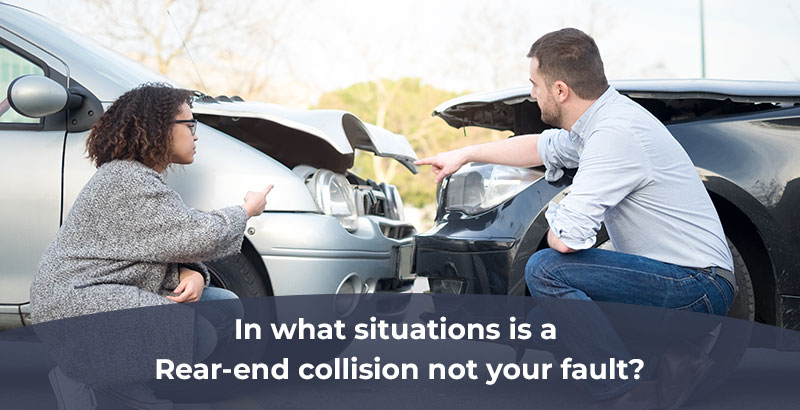It is a common belief that the party responsible for a rear-end collision is the rear vehicle. While there is an initial presumption of negligence against that back car, it is no easy thing to decide who is actually at fault.
For example, the car in front might have done a sudden and unexpected stop in front of our client. Maybe the rear driver had a medical emergency and could not apply the brakes. Perhaps the rear driver’s brakes failed mechanically. The front car could have even acted recklessly, putting the rear vehicle in the unfortunate position of not being able to stop in time to avoid the collision.
At NKS Injury Legal, we do not believe an injury victim should be unfairly blamed for anything. If you’re looking for a rear-end collision lawyer in Calgary, we will help you understand the nuances of the situation. No matter what the situation is, whether the front vehicle can share fault, and protect you from being unfairly forced into a liability claim. We want to help you not be unfairly blamed, but to maximize your compensation when you are not really at fault for a rear-end collision.
Some Exceptions to the Presumption of Rear Driver Negligence
The rear driver is presumed to be at fault for a rear-end collision. An important point to keep in mind is that this presumption of fault is not absolute: mere evidence or testimony of negligence by the back driver is not the end of the liability discussion. You must look at the whole circumstance of the evidence, especially any events that are beyond the rear driver’s control. There are valid legal grounds for disputing liability if the rear driver acted in a reasonable manner. Additionally, ensure that you connect with an experienced rear-end collision lawyer in Calgary.
Here are some notable exceptions:
- Sudden Stops: Since a front driver can stop abruptly and without warning and/or without cause, under such situations, it may be impossible for the rear driver to be able to stop for their impending stop. Even if they have been paying attention and have no other issues, it can be impossible to stop the impact.
- Mechanical Failures: Equipment failures, such as brake failures, that cause the rear driver to be unable to stop, are a way to show a lack of fault on the driver, potentially. If the driver has undergone routine maintenance and has a recently documented brake problem that resulted in a complete, unforeseen brake failure, ultimately implicating the front driver, the rear driver may be found to have no fault in the decisions of the front driver.
- Medical Emergencies: If the rear driver suffers an unforeseen medical episode, such as a seizure or blackout that impedes their ability to stop may indicate they also have no fault. If a rear driver has a prehistory of such episodes, it can help demonstrate that the rear violation was completely unfortunate due to the unforeseen medical crisis.
- Unforeseeable Road Hazards: If the rear driver strikes an object before hitting the front car, that object may help demonstrate a lack of liability for the rear driver. Drivers can not be expected to predict that debris will be moving at highway speeds when the debris appears due to the actions of the front driver and/or other third parties.
- Front Driver Negligence: Front drivers’ erratic/unsafe behaviors: If the front drivers exhibit erratic or unsafe behaviors (e.g., making an improper lane change or suddenly swerving into a lane), no longer does the rear driver carry the entire blame, thus indicating the front driver may share blame.
- Visibility Conditions: Highly visibility-obscuring weather, like heavy fog or rain, could potentially make a rear driver collision unavoidable. Lack of visibility could also allow the rear driver to invoke the “sudden emergency doctrine,” possibly negating the rear motorist’s liability.
Gather Evidence To Prove No Fault
If you wish to rebut the presumptions of liability above, it would be necessary to gather sufficient supporting evidence. There is often considerable emphasis on objective evidence in liability disputes, particularly when establishing reasonable alternative explanations for the crash. Even though there are usually many presumptions set forth that assume the rear driver is completely at fault. For that, you must have factual proof that may suggest the front motorist or an emergency situation unrelated to either party shares fault. These things can be tactfully proved and explained by a rear-end accident lawyer in Calgary. So, it’s better to connect with them.
Examples of evidence are:
- Police Reports and Statements: Police accident report(s) with officer findings and statements from all taxi drivers involved in the crash.
- Photographs of vehicle(s), skid and/or contact marks, and/or hazards: Photographic evidence of significant mechanical issues, road hazards, or damage to the vehicles that supports your claim.
- Vehicle computer diagnostics: Data retrieved from the vehicle systems embedded on board, such as speed, braking, and what speed the vehicle was stopped.
- Witness Accounts: Passenger, pedestrian, or other witness testimony that supports the circumstances that excuse liability of the rear driver.
- Video Recording: Dash cam video or security camera video that shows proof of the cause of the collision, like a specific action of the front driver.
- Medical Records: Reports of any prior conditions or medical history that may have caused a medical emergency at the time of the incident that resulted in the accident.
Great documentation of sudden hazards, prior medical conditions, front driver errors, or mechanical defects can provide good grounds to dispute liability, as opposed to being based solely on witness testimony.
Commonly Asked Questions about Rear-End Accidents and Fault
- Is it possible to not be at fault in a rear-end collision?
Yes, it is possible. There are scenarios where the front driver (with the rear driver in motion) unexpectedly brakes with no reason, or if the driver has brake lights that did not work, or if they chose to back up fast with no bedside manner, or if another vehicle pushed the rear driver into them.
- When wouldn’t the rear driver be at fault?
A rear driver may not be at fault if the front driver suddenly stops their vehicle without any reason, has a medical emergency causing them to stop, has cut the rear driver off dangerously, or you have a road hazard or inclement weather that is not foreseeable.
- Is it possible for the front driver to be at fault in a rear-end crash?
Yes. If the front driver is negligent because they are sudden braking, inappropriately switching lanes, or swerving into the rear car’s path, the front driver adds a layer of fault to the incident.
- How can you prove the other driver is responsible for the rear-end accident?
Evidence is key. Police reports, witness accounts, pictures of both cars, pictures of the accident site, computer data from the cars involved, video footage (from a dash cam or security camera), and medical paperwork if there was a medical emergency.
- Is someone who rear-ends someone else automatically at fault?
No. There is a presumption of fault against the rear driver, known as a rebuttable presumption; if you can show that the rear driver was not at fault because of a medical emergency, a mechanical failure, an unforeseen hazard on the roadway, or by the fault of the front driver, the presumption disappears.
Don’t Let Insurers Sue You More Than They Should – NKS Injury Legal
Being blamed for an accident that you did not cause, especially while you are recovering from injuries yourself, adds insult to injury. At NKS Injury Legal, our expert accident lawyers fight for our clients’ rights. We have ways of challenging an insurer’s unfair liability assessment. We can use comprehensive police reports, innovative technology, persuasive eyewitness accounts, and established legal precedents.
As a trusted rear-end accident lawyer in Calgary, we are skilled at negotiating with insurers. We compel them to adjust their approach to fault attribution and ensure full recovery for our clients who are not at fault. Do not be falsely accused of wrongdoing. Let NKS Injury Legal handle the liability dispute and the legal process so you can focus on your recovery.

